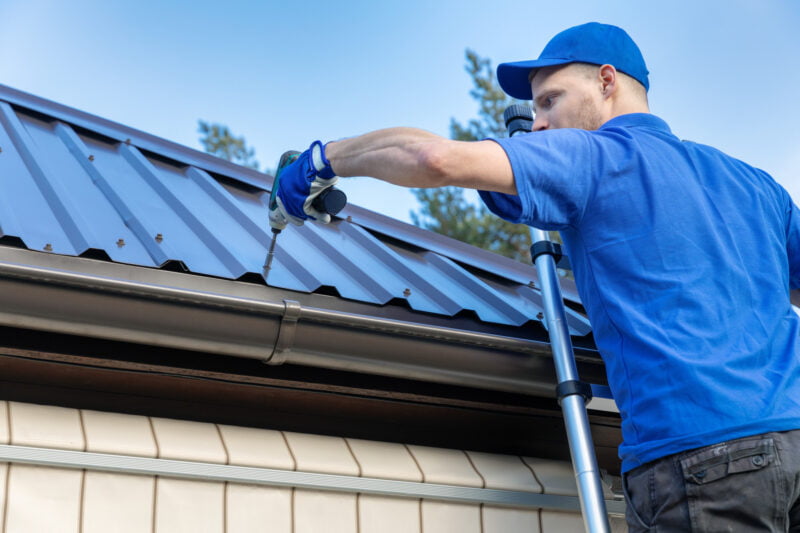Did you know that five million roofing systems get installed in the US each year? Some of those are for new constructions, while the rest goes toward existing homes.
So, it’s no wonder that the US roofing market has become a nearly $15 billion market. What’s more, experts project this sector to reach a value of $17.64 billion by 2025.
All that should give you an idea of how expensive roofing systems can get. That’s especially true if you compare the price of a metal roof VS shingles. However, that higher cost is justifiable, as metal roofing systems usually outlast shingles.
So, how exactly do metal roofs compare to roofing shingles? What are the pros and cons of either, and which one should you get for your home?
We’ll get to the bottom of all those questions in this guide, so be sure to keep reading!
What Is a Metal Roof?
Metal roofing consists of large, flat sheets of metal cut in lengthwise patterns. Some metal roofs come with corrugated metals, while others use flat seams. Either way, fasteners secure the interlocked sheets to the underlying roof frame.
What About Shingles?
Shingles are roof covering made of interlocking or overlapping tiles. Asphalt, also known as bitumen, is the most common type of roofing shingles. However, some shingles can also consist of wood, slate, or even plastic.
Factors Distinguishing Metal Roof VS Shingles
Because of their materials, the applications for metal roofing and roofing shingles vary. For the same reason, they have different lifespans and maintenance requirements.
As a result, their sustainability and prices widely differ, too.
Materials
Metal roofing can take the form of aluminum, copper, or steel sheets. As metals, they all feature combustion- and fire-resistant properties. Their composition also makes them wind-resistant.
As for weight, aluminum is one of the lightest, as it only weighs about a third of copper or steel. That’s also why aluminum is a preferred material in aircraft and motor vehicles.
On the other hand, composite roofing shingles usually consist of three base materials.
There’s fiberglass, which acts as the base or the foundation of the shingles. The composite material, such as asphalt, then goes on top. Finally, granules made of crushed stones cover the roofing shingles.
Applications
Asphalt shingles are the most common roof covering in the United States. So much so that about three in four roofs in the US use these materials.
One reason is that asphalt shingles are accessible and widely available. They’re also suitable for most homes, although they do have minimum slope requirements.
Metal isn’t as popular as asphalt shingles, but demand for it is on the rise. For instance, the US metal roofing market share for new construction was 8% in 2019, a 4% increase from 2018. The demand for existing homes is even higher at 12%.
Metal roofing is more common in commercial buildings which have low-sloped conditions. So, if the same describes your home, you may want to consider a metal roof.
Longevity
The 3-tab kind of asphalt shingles lasts for an average of two decades. On the other hand, wood shingles have a mean lifespan of 25 years. By contrast, genuine slate shingles can be in service for 60 to 150 years.
If you go metal, you can expect your roof to last for at least 40 years. However, this goes up to 70 years for copper roofing.
Maintenance
Since most metal roofs are smooth and low-sloped, they usually require minimal maintenance. For instance, you can hose them down with water to clean them off.
However, it’s imperative to keep the connecting gutters free of debris. Doing so can help ensure that rain or melted snow can run off the metal sheets.
Shingles need more care, seeing as they consist of individual, albeit overlapping tiles. Moreover, their construction makes them susceptible to debris accumulation. As such, shingled roofs need more regular cleaning and debris removal.
Asphalt shingles are also sensitive to external forces, especially their outermost granules. For example, harsh cleaners can knock off their crushed stone covering.
Sustainability
Almost all forms of metal are recyclable, including those used in roofing systems. For example, aluminum is 100% recyclable, and so are copper and steel. That feature also protects them from losing their properties even after recycling.
That recyclability makes metal roofs some of the most sustainable roofing options. For starters, they won’t end up in landfills after serving their purpose as roof materials. Instead, recycling facilities can turn them into raw materials for new products.
On the other hand, the majority of asphalt shingles don’t undergo recycling.
For instance, an estimated 11 million tons of asphalt shingles in the US end up as waste each year. For this reason, they make up a considerable percentage of the country’s waste stream.
In addition, asphalt shingles also play a role in the depletion of petroleum. After all, making asphalt involves distilling petroleum or crude oil. That distillation creates asphalt deposits that can then go into manufacturing roof shingles.
Unfortunately, petroleum is a derivative of non-renewable fossil fuels. They’re non-renewable because fossil fuels take hundreds of millions of years to form. That’s also why the world’s supply of petroleum is close to exhaustion.
Prices
Metal roofing can cost twice or thrice the price of other roofing materials. However, keep in mind that metal roofs can last about two to four times as long. That longer lifespan plus minimal maintenance may be enough to outweigh their cost.
On the other hand, affordability is one of the primary benefits of shingles made of asphalt. Asphalt shingles are, in fact, the least expensive roofing option. For the same reason, you can expect shingle roof replacement to be on the affordable side.
Invest in a High-Quality Roofing System
There you have it, your ultimate metal roof VS shingles comparison guide. Now, you know that metal roofs last longer and are more sustainable. However, they also cost more, which is why shingles remain an attractive option.
Regardless of what you choose, though, be sure to go for high-quality roofing materials. The best way to ensure this is to hire a licensed roofer offering a lengthy roof warranty.
Did you find this guide informative? If so, check out other blog posts that you may find just as enjoyable!




